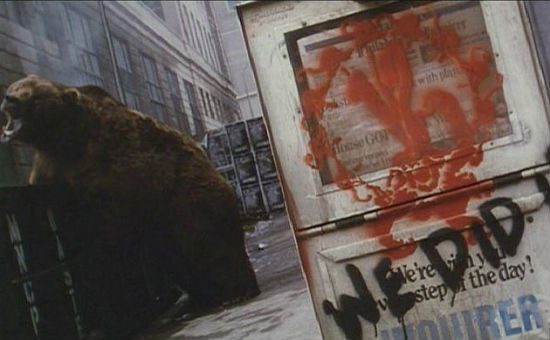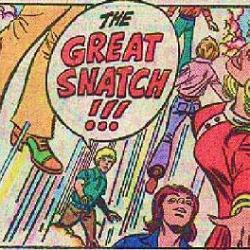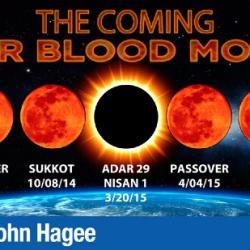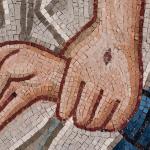Originally posted April 24, 2009.
You can read this entire series, for free, via the convenient Left Behind Index. The ebook collection The Anti-Christ Handbook: Volume 1, is available on Amazon for just $2.99. Roe, Griswold, and Brown are out; Shelby County, Cruikshank and Plessy are back in. Volume 2 of The Anti-Christ Handbook, completing all the posts on the first Left Behind book, is also now available. Volume 3 is coming soon(ish).
Tribulation Force, pp. 21-29
The Left Behind books are filled with vast, massive impossibilities — every child on earth vanishes and everyone’s daily routine continues unaltered; a jetliner makes a harrowing emergency landing, threading its way amidst the unprecedented wreckage of a half-dozen passenger planes, and no one on board ever gives it a second thought; a passage that reads, “I looked, and there was a white horse! Its rider had a bow; a crown was given to him, and he came out conquering and to conquer” is interpreted “literally” as foretelling the arrival of some hippy peacenik.
Against the backdrop of such epic madness it’s easy to lose sight of these books’ smaller, more intimate impossibilities. Yet here we come to another reminder that the interpersonal events recounted here are every bit as strange, alien and inhuman as the international ones:
Chloe looked at [Buck] expectantly when she greeted him, yet she did not hug him, as Steele and Bruce Barnes had done. Her reticence was his fault, of course. They barely knew each other, but clearly there had been chemistry. They had given each other enough signals to begin a relationship, and in a note to Chloe, Buck had even admitted he was attracted to her.
Jerry Jenkins is well-served here by his habit of telling about things like this note without ever showing them to us, because such a note seems, if not quite impossible, at least unimaginable. “Dear Chloe. I admit I am attracted to you. Let us never speak of it again. Cordially, Cameron.”
I appreciate that the target audience for these books includes readers in the hinterlands of the evangelical subculture where dating as it is practiced in most of the West remains a forbidden and largely unknown custom. LaHaye & Jenkins are writing for people who subscribe, instead, to the invented neo-Victorian practices of evangelical “courtship,” as well as for Pensacola students and Bill Gothard Seminar devotees who would view even that stilted practice as dangerously titillating. We’re talking about people whose first date may have been with Dad at a “Purity Ball.” And it’s possible that some readers coming from such a background might relate to the awkward, pre-Disney-Channel-age behavior displayed by Buck and Chloe here.
But these characters are not supposed to be from-the-cradle fundamentalists. Chloe is supposed to be a Stanford student. And Buck is supposed to be a Manhattan sophisticate. The very last scene even seemed to imply, intentionally or not, that he enjoyed seducing the support staff for quickies in train station parking lots.
It’s simply bizarre that two such characters would immediately following their conversion metamorphosize into socially maladept, awkwardly chaste, thoroughgoing Gothardites.
That’s not to say that Buck shouldn’t be feeling some hesitation here. Chloe’s father has been a constant presence since they first met, and most of their interaction has taken place in a pastor’s study. Plus, he’s 30 and she’s 20 — so he’s bordering on Matthew McConaughey in Dazed and Confused skeeviness. At some point, Buck has surely done the arithmetic and realized that by the time Chloe is his age, the world will have ended three years ago.
On the other hand, the Final Countdown has begun and with the big clock ticking, you’d think Buck would be reciting “To His Coy Mistress” with a particular urgency. Add in the general aphrodisiac quality of crisis adrenaline, and these two ought to be on their own personal seventh seal by now. They may be premillennial dispensationalist fundamentalists, but they’re not Shakers for goodness’ sake.
Actually, though, I’m grateful that particular element of realism is lacking here. I really, really wouldn’t want to have to read a Jenkins-scripted love scene. Particularly when what he does write reads like this:
[Buck] had to be careful. … Only a fool would begin a relationship at a time like this. And yet wasn’t that exactly what he was — a fool.
Feh.
Another less-than-convincing passage we skipped past last week involved yet another attempt to recognize that some kind of grieving ought to be occurring in this post-Event world:
[Rayford] had always considered emotion weak and unmanly. But since the disappearances, he had seen many men weep. He was convinced that the global vanishings had been Christ rapturing his church, but for those who remained behind, the event had been catastrophic.
Even for him and Chloe, who had become believers because of it, the horror of losing the rest of their family was excruciating. There were days when Rayford had been so grief-stricken and lonely for his wife and son that he wondered if he could go on.
I’m having a hard time fitting those dark days of “grief-stricken” paralysis into the existing timeline for our story. Rayford’s daily activities since the Event are almost fully accounted for. He hasn’t missed a single day of work. He hasn’t even skipped a meal. Nor has anyone else that we’ve seen.
Here, for the first time, we learn that Rayford has “seen many men weep.” That’s a start, but all the children of the world have been stolen. The world ought, then, to be more full of weeping than we can understand. But we’ve been looking at this post-Event world for nearly 500 pages now and it remains cruelly composed, dry-eyed and unmoved. This 10-word retroactive patch-job — “for those who remained behind, the event had been catastrophic” — can’t begin to correct that. A world of stolen children is not identical to this world, plus a few weeping men. It’s a different world entirely.
There’s no trace of that different world in any of these books.
Anyway, we left off with Bruce discussing what he’s learned about Nicolae Carpathia’s quirkily ambitious agenda for his First 100 Hours as the newly appointed almost-global potentate. We already looked at one bizarre piece of this agenda — relocating the global seat of the One-World Government to Mesopotamia. And now we’ll turn to two more items: the OWC and the OWR.
“The international financial community, whose representatives were already in New York for meetings, has been charged with the responsibility of settling on one currency.”
So representatives of international financial institutions are right there in Manhattan? What are the odds of that?
This idea of one world currency arises, I think, from the passage in Revelation 13 describing the “mark of the beast” (which is actually the mark of the second beast, just to be precise):
He also forced everyone, small and great, rich and poor, free and slave, to receive a mark on his right hand or on his forehead, so that no one could buy or sell unless he had the mark …
LaHaye & Jenkins — and Nicolae — seem to think that establishing such a global monopoly would require a single, global currency. More than that, they seem to think that establishing such a one-currency system would inevitably lead to such a global monopoly. I’m not sure I follow their reasoning there, but at least it’s a change from the usual PMD nonsense about ATMs and UPC codes.
“That’s not all,” Bruce went on. “Do you think it was coincidental that leaders of the major religions were in New York when Carpathia arrived last week? How could this be anything but the fulfillment of prophecy? Carpathia is urging them to come together, to agree on some all-inclusive effort at tolerance –”
BUZZZZ! Tolerance — he said tolerance! We know that’s evil. Tolerance is just a code-word for relativism and a lack of moral absolutes. Tolerance leads to a belief in evolution, homosexuality and Hitler.
I’m really not overstating there. That’s exactly the signal and warning this word is meant to convey. That’s what it means to the authors and to their readers and that’s why it’s included here.
“… to agree on some all-inclusive effort at tolerance that would respect their shared beliefs.”
“Shared beliefs?” Chloe said. “Some of those religions are so far apart they would never agree.”
Chloe is meant yet again to serve as the rational, “intellectual” foil, showing off with all that book-learning she got at Stanford. Unfortunately, her objection doesn’t quite make sense. It is certainly true that the world’s various different religions are “far apart” on many matters of doctrine about which none of them would ever be willing to compromise. That’s why they’re various and different. But that fact doesn’t preclude the existence of another set of “shared beliefs.” And it isn’t hard to come up with a fairly long list of such shared beliefs: the Golden Rule; honesty is good; betrayal is bad; courage is good; preying on the defenseless is bad; hospitality is good. Christians and Muslims, for example, can agree on all of those things even though they will never agree on the Five Pillars or the doctrine of the Trinity — that’s why they’re either Christians or Muslims.
So Chloe’s rational objection here isn’t really all that rational. In any case, Bruce once again dismisses her:
“But they are agreeing,” Bruce said. “Carpathia is apparently making deals. I don’t know what he’s offering, but an announcement is expected by the end of the week from the religious leaders. I’m guessing we’ll see a one-world religion.”
“Who’d fall for that?”
“Scripture indicates that many will.”
Poor silly Chloe is still trying to make sense of the prophecies, so once again Bruce has to correct her: They don’t have to make sense, they’re prophesied.
If you’re someone who believes anything other than the particular brand of Christianity that L&J believe, then please note what’s being suggested about you here. Carpathia is able to get everyone to abandon the essence of what they believe by “making deals.”
What L&J are suggesting here is that all those people who supposedly believe all that other stuff besides Real, True Christianity don’t really believe it at all. In the authors’ view, those other religions are well on their way to uniting in a single faith because they already have so much in common. They all share the same starting point — the rejection of Jesus Christ as their personal Lord and Savior. And they all secretly know that they’re based on falsehoods that no one could really believe. And they’re all wrong.
The idea seems to be that any supposed difference between these various “false” religions cannot be sincere. Passionate sincerity, after all, is the mark of true faith.
Rayford finds all of this Antichrist business unsettling:
Rayford actually knew two people — Buck and Hattie — who had personally met the Antichrist! How bizarre was that? When he allowed himself to dwell on it, it sent a dark shiver of terror deep inside him.
He seems to possess a fully formed fear and revulsion of the “Antichrist.” How did that happen so quickly? Such “a dark shiver of terror” might make sense for Bruce, who spent years listening to the Rev. Billings’ Antichrist horror stories. But Rayford is still a novice. He wouldn’t seem to know enough yet — the name shouldn’t frighten him much more than the names Sauron, Voldemort or Darth Vader might frighten someone unfamiliar with the stories in which those characters appear.
Rayford’s knowledge about the Antichrist seems to violate one of the implicit conceits of the Left Behind series — namely, as we’ve discussed before, that the Left Behind series is set in a world in which nothing like the Left Behind series exists. The unsaved masses are presumed to be wholly ignorant about Jesus and even the most general sense of the PMD prophecy mythos. These people aren’t even able to recognize a Rapture when they see one firsthand. Attributing such ignorance to them is necessary for this story to work, because if most of the doomed were aware of the prophecy check list, and they behaved accordingly, then the prophecy might not be fulfilled. So Tim LaHaye cannot be allowed to exist in the world of Left Behind. Or at least, if he does, his writings must remain obscure and unread in that world.
Here in our real world, of course, the broad outline of Tim LaHaye’s views are widely known and tens of millions of copies of his books circulate in print. Hundreds of pastors have also, at LaHaye’s urging, recorded their own versions of In Case of Rapture videotapes. So if it turns out that 2,000 years of Christian theology are wrong and the future does begin to unfold as LaHaye says it will, those who are left behind should recognize what they’re up against and they’ll have plenty of resources to get ready. In our real world, the rise of the Antichrist wouldn’t just conjure up the vague dread Rayford feels, it would prompt a massive, armed response from masses of people who would always be two steps ahead of the Antichrist’s schemes. He wouldn’t stand a chance.
Thus, by outlining their prediction in such detail, L&J may have, unwittingly, ensured that it can never come to pass. (Which is kind of the opposite of the plot of Twelve Monkeys.)

On top of the OWG, OWC and OWR and their planned relocation to New Babylon, Bruce says there was one more piece of Carpathia’s agenda “that really got to me”:
“The next major order of business for Carpathia is what he calls ‘an understanding’ between the global community and Israel, as well as what he calls ‘a special arrangement’ between the U.N. and the United States.”
So there’s this One-World Government, OK? A global community encompassing every nation on earth. And it sets up diplomatic relations with Israel. And with the United States.
But wait, if the OWG includes every nation on …? Oh, never mind.
Bruce isn’t sure what to make of the deal with the U.S., “because as much as I study I don’t see America playing a role during this period of history.” That’s an almost verbatim quote from Tim LaHaye’s stock answer whenever he is asked about the role of America in the End Times. He seems genuinely perplexed by this mystery. “As much as I study,” he says, he can’t seem to find any mention of America in Revelation, or Daniel, or Ezekiel.
It’s eerie. It’s almost as though the authors of those books didn’t even know this hemisphere existed.
Carpathia’s “understanding” with Israel is, of course, the Antichrist’s peace treaty — complete with built-in expiration date.
Chloe looked up. “And that actually signals the beginning of the seven-year period of tribulation.”
“Exactly.” Bruce looked at the group. “If that announcement says anything about a promise from Carpathia that Israel will be protected over the next seven years, it officially ushers in the Tribulation.”
This brings us to an odd little tangent to allow LaHaye to expound on one of the trademark features of his individual brand of PMD. Every “Bible prophecy expert” needs to have several such distinguishing flourishes. These men are the cartographers of the End Times, each redrawing a map whose outlines were long ago established and refined by Darby, Scofield, Ironsides, Lindsay, et. al. To demonstrate the value of their own contribution to the established “scholarship” — and thus to get booked as the keynote speaker at more church prophecy conferences — relative newcomers like LaHaye have to toss in some signature embellishments. The naked Rapture is one of LaHaye’s. So too are the early appearance of the Two Witnesses and his emphasis on the milestone of the 3.5-year midpoint of the Tribulation (which is why this book is so uneventful).
And Bruce is about to explain another piece of LaHaye’s trademark arcana:
Buck was taking notes. “So the disappearances, the Rapture, didn’t start the seven-year period?”
“No,” Bruce said. “Part of me hoped that something would delay the treaty with Israel. Nothing in Scripture says it has to happen right away. But once it does, the clock starts ticking.”
This is part catechism, part polemic. Details like this are the stuff of heated arguments among prophecy seminar headliners. LaHaye is firing a shot in one such argument here: “No … nothing in Scripture says …” Them’s fightin’ words, and those no-good heretics who claim that the seven-year period begins with the Rapture won’t take that sitting down, either. This is deadly serious stuff.
Deadly dull stuff, too, so let’s not worry as much about the particulars of the dispute as about the strange idea here of this vague period of stoppage time before the End of the World.
Why were Bruce and his hapless Tribulation Force comrades just sitting around idly for the past two weeks when he knew they had only a short, indeterminate window in which they might arguably have been able to forestall — or even to prevent — the onset of the Great Tribulation.
Two days ago, remember, Buck and the Antichrist-to-be and a loaded gun were all together in one room. If Buck had appreciated the urgency of this brief opportunity, he might have made better use of that promising circumstance.
And what if he had succeeded? What if, instead of silently weeping through Carpathia’s double-homicide hypnosis act, Buck had managed to get his hands on the gun and to kill Carpathia? Does Satan (or God, or the two of them co-operatively — I’m not sure how this whole designation of an Antichrist process works) have an understudy waiting in the wings? Sure, killing Nicolae might just mean they call up the next guy from the minors, but I’d rather face the rookie than the starting team.
But what if there isn’t a roster of backup Antichrists available? No Antichrist would have meant no treaty with Israel. And that would have meant no seven-year period and thus, in turn, no End of the World. So would God then have to put all the children and the RTCs back from where he took them? Or would the world just kind of limp along in loophole limbo until the heavenly attorneys could sort this mess out?
We’ll never know the answer to any of those questions, of course, since our supposed action heroes wasted their window of opportunity passing notes and harassing their co-workers.
















